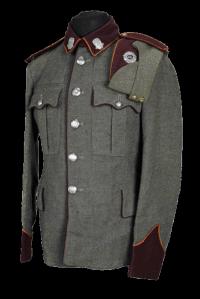The Volunteer Force, 1934–46
Published in 20th-century / Contemporary History, Devalera & Fianna Fail, Features, General, Issue 6 (Nov/Dec 2011), Volume 19
Volunteer Force uniform—differed from the regular army and was based on Casement’s Irish Brigade, recruited among Irish POWs in Germany during the First World War. (National Museum of Ireland)
Drawing on the revered heritage of the Irish Volunteers, the Fianna Fáil government created the Volunteer Force on 6 April 1934. This part-time militia was intended to appeal to the party’s republican supporters, and to offer them an alternative to membership of the IRA. Recruiting posters stressed the specifically Irish nature of the new force, while the uniforms differed from those of the regular army and were based on Casement’s Irish Brigade, recruited among Irish POWs in Germany during the First World War. Twenty-one former republicans had already been drafted into the Irish Army as officers to oversee the recruiting of the Volunteer Force, thus avoiding the traditional two-year officer cadetship. In its first year a substantial sum of £250,000 was allocated for the nationwide force, which it was hoped would have 24,000 volunteers. At a local level the Force was run with the assistance of a civilian committee known as a ‘Sluagh’. These became known as ‘Aiken’s Slugs’ after the minister for defence who appointed them. Seán Lemass, the new minister for industry and commerce, writing to cabinet colleagues, saw the Volunteer Force primarily as a tool against illegal paramilitary organisations such as the IRA and the Blueshirts: ‘the primary purpose of any Volunteer scheme in the present circumstances of the Saorstat is a political one, i.e. the provision of an opportunity of military training in a manner beneficial to the State to young men to whom military manoeuvres are an attraction and who if they do not get the association they desire in an official organisation may be induced to seek it in illegal organisations’. In the years before World War II strategic defence policy was left to larger European countries, while local political needs and realities dominated the defence policies of small countries such as Ireland. It quickly became clear, however, that the Volunteer Force was not as successful as first hoped. Despite the attention of two cabinet committees in 1936 and 1939, the Force was dogged by a series of problems and recruiting began to tail off. Between March 1934 and March 1939, 16,146 men joined the Force, but when it was reorganised on 1 March 1939 only 3,731 Volunteers re-enlisted. Once the Emergency began, the Force was quickly subsumed into the regular army, playing a key role in providing men for the Coast Watching Service, and was finally replaced by An Forsa Cosanta Áituil (FCA) in 1946. HI
Lar Joye is curator of military history at the National Museum of Ireland (Decorative Arts and History).
















